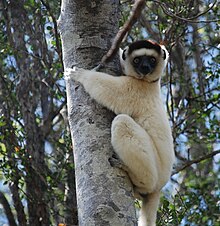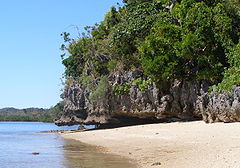Madagascar dry deciduous forests
| Madagascar dry deciduous forests | |
|---|---|
Uroplatus guentheri | |
| Bird species | Bernier's teal, Madagascar fish eagle, Sakalava rail |
| Mammal species | Golden-crowned sifaka, mongoose lemur, golden-brown mouse lemur |
| Geography | |
| Area | 152,100 km2 (58,700 sq mi) |
| Country | Madagascar |
| Elevation | 0–600 metres (0–1,969 ft) |
| Coordinates | 17°36′S 45°12′E / 17.600°S 45.200°E |
| Geology | varied |
| Climate type | Tropical savanna climate (Aw) |
| Conservation | |
| Conservation status | Critical/Endangered |
| Global 200 | included |
| Protected | 5.79%[1] |
The Madagascar dry deciduous forests represent a
Geography
There are two separate areas within the ecoregion: the western side of Madagascar from the Ampasindava peninsula in the north to
These dry deciduous forests span the coastal plain with its limestone plateaus emanating virtually at sea level to higher altitudes to roughly 600 metres (2,000 ft). The area includes wetlands and grasslands (mostly created by forest clearance for agriculture) as well as dry forests characterized by a deciduous canopy extending to a height of 10 to 15 metres (33 to 49 ft).[2]
Climate is tropical, with summer daytime temperatures commonly exceeding 30 °C (86 °F), and a wet season between October and April.
Flora
While the absolute number of plant species is lower than in the eastern rainforests of the island, the dry deciduous forests of Madagascar have a higher ratio of
Fauna

One characteristic in common with other
The lakes and rivers of the dry forest region are homes to most of Madagascar's bird species. Among reptiles, many
Threats and conservation
Most dry forests have already been destroyed by human action, especially near the Central Highlands. The remaining forest is severely fragmented. Burning, grazing, and logging are the major threats, and siltation, overfishing and invasive species impact the wetlands. Some species such as lemurs suffer from hunting.[2]
5.79% of the ecoregion is in protected areas.[1] They include:[2][1]
- Ankarafantsika National Park
- Baie de Baly National Park
- Bemaraha National Park
- Montagne d'Ambre National Park
- Namoroka National Park
- Tsingy de Bemaraha Strict Nature Reserve
- Ambohijanahary Reserve
- Analamerana Special Reserve
- Ankarana Special Reserve
- Bemarivo Reserve
- Bora Reserve
- Kasijy Special Reserve
- Maningoza Reserve
- Manongarivo Reserve
- Tampoketsa Analamaitso Special Reserve
Particular localities
Ankarana Special Reserve
The
The Ankarana Special Reserve is one of the northernmost reaches of the Madagascar dry deciduous forests, and is very hot from December through March with this equatorial proximity. Access to wildlife viewing is through strenuous hiking, given the elevation differences, complex terrain and heat, but four-wheel drive vehicles can reach most of the actual campsites. Below the massif, and to the west, is a grassy savannah-with-palms that leads to the Indian Ocean. Within the massif, Lac Vert is found among tsingy formations.
Mammals found in this forest include the
Some bird species commonly seen are the
Anjajavy Forest

Anjajavy Forest is an example of a purely lowland dry deciduous forest in northwest Madagascar. It is punctuated with numerous tsingy outcroppings and limestone karst caves, and in many locations abuts the Indian Ocean, especially where the dramatic tsingy formations jut out into the ocean. The canopy height is typically 15 to 25 meters high, and is at its lowest at the coastal verge, where growth may be impeded by saline rocky soils. The forest resides on a small peninsula of land poking into the Indian Ocean, that is bounded on the north and part of its eastern extent by the Bay of Narinda and on the south by the Bay of Majajamba. Access to this forest is difficult since there are no roads connecting this peninsula to the Madagascar highway system; however, arrival by sea and by air are accomplished with some effort.[9]
In many places at the ocean edge as well as forest interior, several tree species are capable of taking root directly in the tsingy rocks. Several species of baobab and
The Anjajavy Forest is named for a kind of
The dry forest is invaded by fingers of
See also
References
- ^ a b c Madagascar dry deciduous forests. DOPA Explorer. Accessed 8 September 2022.
- ^ ISBN 978-1559633642. Archived from the original(PDF) on 2016-11-01.
- ^ "IOSPE PHOTOS". www.orchidspecies.com.
- ISBN 978-1-874687-48-1.
- ^ Nick Garbutt, Mammals of Madagascar, Pica Press (1999)
- PMID 2807091.
- ^ Nick Garbutt, Hilary Bradt and Derek Schuurman, Madagascar Wildlife, Globe Pequot Press (2001)
- ISBN 1-74104-100-7
- ^ Nick Garbutt, Hilton Hastings, Wendy Pollecutt, C. Michael Hogan, Tahiana Andriaharimalala, Anjajavy, the village and the forest. May, 2006
